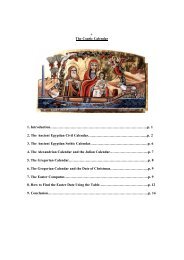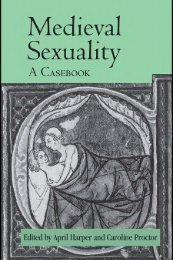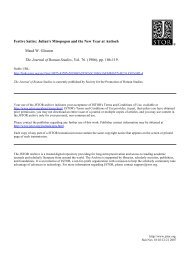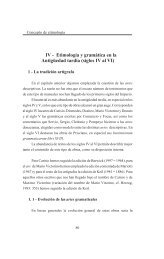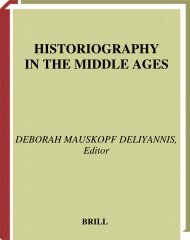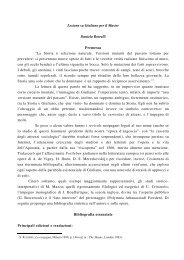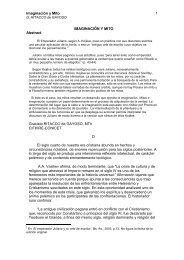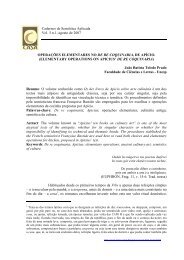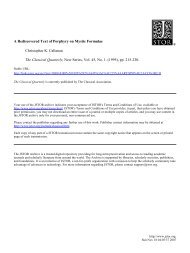Fatal Wounding of the Byzantine Emperor Julian the Apostate (361 ...
Fatal Wounding of the Byzantine Emperor Julian the Apostate (361 ...
Fatal Wounding of the Byzantine Emperor Julian the Apostate (361 ...
You also want an ePaper? Increase the reach of your titles
YUMPU automatically turns print PDFs into web optimized ePapers that Google loves.
618 World J. Surg. Vol. 24, No. 5, May 2000recommended <strong>the</strong> same for <strong>the</strong> consistency <strong>of</strong> <strong>the</strong> thread; <strong>the</strong>ymust not be so hard as to tear <strong>the</strong> skin nor so s<strong>of</strong>t as to breakeasily. The distance <strong>of</strong> <strong>the</strong> piercing from <strong>the</strong> margins <strong>of</strong> <strong>the</strong> woundmust be average; that is, <strong>the</strong>re must not be so great a distance that<strong>the</strong> margins do not make good contact or too close so as to tear<strong>the</strong> skin [20]; <strong>the</strong>se requirements are generally accepted today.Suturing abdominal wall wounds was also recommended in <strong>the</strong>work <strong>of</strong> Celsus, De Medicina (first century A.D.). That writerpreferred stitches in layers, first <strong>of</strong> <strong>the</strong> skin and muscular wall and,second, <strong>of</strong> <strong>the</strong> parietal layer <strong>of</strong> <strong>the</strong> peritoneum, using for eachlayer two needles armed with thread and cross-suturing [23].After <strong>the</strong> stitching, Galen suggested application <strong>of</strong> “<strong>the</strong> drugsfor fresh wounds,” <strong>the</strong> well known enheme drugs from <strong>the</strong> CorpusHippocraticum and mainly inunctions <strong>of</strong> warm olive oil and injection<strong>of</strong> <strong>the</strong> same substance by <strong>the</strong> clyster into <strong>the</strong> abdominalcavity [20, 22].Oribasius’s Treatment <strong>of</strong> <strong>the</strong> <strong>Emperor</strong> <strong>Julian</strong>It is likely that such treatment was carried out by Oribasius in <strong>the</strong>case <strong>of</strong> <strong>Julian</strong>. This technique <strong>of</strong> “gastrorrhaphy” would be familiarto <strong>the</strong> eminent physician because it is mentioned in his anatomicdescription <strong>of</strong> peritoneum [24]; <strong>the</strong> lack <strong>of</strong> a detailed description<strong>of</strong> it could perhaps be interpreted by <strong>the</strong> fact that onlypart <strong>of</strong> his ambitious voluminous work has survived. His Epitomae,especially, completed after <strong>361</strong> at <strong>the</strong> order <strong>of</strong> <strong>Julian</strong>, whichsummarized Galen’s work and <strong>the</strong>refore in all probability wouldhave included his techniques for repairing <strong>the</strong> injured abdomen,has been lost [25]. However, Aetius <strong>of</strong> Amida (sixth century) andPaul <strong>of</strong> Aegina used it as a source [25]. Hence a description <strong>of</strong> <strong>the</strong>latter concerning “gastrorrhaphy” derived from Galen is possiblybased on this lost work, a hypo<strong>the</strong>sis justified by <strong>the</strong> many gaps in<strong>the</strong> chapter describing <strong>the</strong> procedure.A question might arise as to whe<strong>the</strong>r suturing <strong>the</strong> intestinescould be achieved in <strong>Julian</strong>, as <strong>the</strong>re is clear information from <strong>the</strong>historical texts that <strong>the</strong>re was a wound to or severing <strong>of</strong> <strong>the</strong>intestines, with escape <strong>of</strong> <strong>the</strong>ir contents.Paul <strong>of</strong> Aegina, copying <strong>the</strong> text <strong>of</strong> Galen, did not refer to thissubject; nor did <strong>the</strong> text <strong>of</strong> Galen contain any information on thispoint [20, 21]. Both texts, however, refer to <strong>the</strong> fact that “<strong>the</strong> largeintestines are curable and <strong>the</strong> small are difficult to cure; <strong>the</strong>jejunum in particular is incurable because <strong>of</strong> <strong>the</strong> number and size<strong>of</strong> its vessels and its thin wall which is full <strong>of</strong> nerves and because<strong>the</strong> jejunum is a receptacle for <strong>the</strong> bile emitted from <strong>the</strong> liverundissolved, as <strong>the</strong> latter is located very near.” The same opinionwas previously expressed by Celsus, with <strong>the</strong> difference that <strong>the</strong>relative extract is completed by <strong>the</strong> author as follows: “When this[wound] happens we must first examine whe<strong>the</strong>r <strong>the</strong>y [<strong>the</strong> intestines]are uninjured. If <strong>the</strong> smaller intestine has been penetrated,no good can be done. The larger intestine can be sutured, not withany certain assurance, but because a doubtful hope is preferableto certain despair; for occasionally it heals up” [23]. This commonopinion <strong>of</strong> ancient writers coincides with <strong>the</strong> modern conceptsaccording to which a wound to <strong>the</strong> large intestines has betterhealing and prognosis than one to <strong>the</strong> small intestine. Celsusreferred to <strong>the</strong> technique with reservations, which were absolutelyjustified during an era when surgery was not advanced and peritonitiswould have been a frequent complication <strong>of</strong> intestinalwounds. Moreover, this was before asepsis and antibiotics wereknown.Consequently, it is possible that Celsus and Galen had a commonsource, as each had based his concepts on Hellenistic medicaltexts [1, 2]. It seems from <strong>the</strong> description by Galen that <strong>the</strong> rest <strong>of</strong><strong>the</strong> concept, which justifies and interprets why <strong>the</strong> large intestinesare more curable (greater possibility <strong>of</strong> being sutured), is missing.On <strong>the</strong> o<strong>the</strong>r hand, Galen and Paul <strong>of</strong> Aegina must have known<strong>the</strong> text <strong>of</strong> <strong>the</strong>ir predecessor, Celsus. It would thus be rational toconclude that in some cases <strong>the</strong> <strong>Byzantine</strong> physicians also sutured<strong>the</strong> large intestine despite <strong>the</strong> difficulty <strong>of</strong> <strong>the</strong> procedure andpossibly <strong>the</strong>ir reservations.Ano<strong>the</strong>r case <strong>of</strong> abdominal wall wounding can be found in <strong>the</strong>texts <strong>of</strong> <strong>Byzantine</strong> historians and chroniclers. It concerns <strong>the</strong>wounding <strong>of</strong> <strong>Emperor</strong> Basil I <strong>the</strong> Macedonian (867–886), founder<strong>of</strong> <strong>the</strong> famous Macedonian dynasty <strong>of</strong> Byzantium, who was injuredwhen a deer attacked him during a hunt and lacerated his abdomen.In this case no reference is made to abdominal suturing,owing to <strong>the</strong> fact that in similar cases <strong>of</strong> wounding by wild beastssuch as <strong>the</strong> wild boar <strong>the</strong> <strong>Byzantine</strong> physicians preferred delayedhealing, a form <strong>of</strong> treatment encouraging <strong>the</strong> appearance <strong>of</strong> pus,which <strong>the</strong>y consider a more effective technique after wounding bybeasts. The emperor Basil I died after 9 days with a high fever; <strong>the</strong>historians referred to <strong>the</strong> symptoms <strong>of</strong> pain, hemorrhage, diarrhea,great exhaustion, and finally <strong>the</strong> accompanying high fever.Probably <strong>the</strong> emperor succumbed to peritonitis [26].ConclusionsBased on research <strong>of</strong> historical sources that referred to <strong>the</strong> fatalabdominal wounding <strong>of</strong> <strong>the</strong> <strong>Emperor</strong> <strong>Julian</strong> and study <strong>of</strong> <strong>the</strong>medical knowledge <strong>of</strong> his era derived from <strong>the</strong> texts <strong>of</strong> Celsus andGalen, we reached some conclusions concerning <strong>the</strong> possiblesurgical confrontation <strong>of</strong> wounds in <strong>the</strong> abdomen during <strong>the</strong> early<strong>Byzantine</strong> period, when surgery was impregnated by <strong>the</strong> concepts<strong>of</strong> Greek-Roman medicine. The combination <strong>of</strong> pharmaceuticaltreatment and surgical techniques for dealing with <strong>the</strong>se wounds,referred to by Celsus and more meticulously by Galen, whotransferred knowledge <strong>of</strong> Alexandrian and ancient Greek medicine,permit <strong>the</strong> supposition that <strong>the</strong> famous <strong>Byzantine</strong> physicianOribasius confronted <strong>the</strong> wounding <strong>of</strong> <strong>Emperor</strong> <strong>Julian</strong> accordingto <strong>the</strong> principles <strong>of</strong> treatment <strong>of</strong> his predecessors. It includedreplacing <strong>the</strong> intestines, perhaps suturing <strong>the</strong>m where possible,irrigating <strong>the</strong> wound with wine, and detailed suturing <strong>of</strong> <strong>the</strong>abdominal wall according to <strong>the</strong> instructions and techniques derivedfrom earlier medical texts. He added application <strong>of</strong> drugssuitable for enheme wounds. However, a major hemorrhage occurredon <strong>the</strong> third day, possibly from an injury to <strong>the</strong> liver, whichcaused <strong>the</strong> wound to reopen despite <strong>the</strong> fact that Oribasius, anexperienced surgeon, would have observed all <strong>the</strong> requirements <strong>of</strong>a lege artis suture. For this reason a historian remarked ironicallythat <strong>the</strong> wound ridiculed all <strong>the</strong> treatments <strong>of</strong> <strong>the</strong> eminent physician.Hemorrhagic shock followed, which brought about <strong>the</strong> death<strong>of</strong> <strong>the</strong> emperor. Because <strong>of</strong> <strong>the</strong> short time between <strong>the</strong> injury andhis death, signs <strong>of</strong> peritonitis did not appear.RésuméLa chirurgie byzantine a fleurie dès le début de l’empire Byzantin(324–1453 après Jésus Christ). Les premiers médecins importantsbyzantins, dont le plus éminents, Oribasius de Pergamun (4èsiècle), ont non seulement compilé des œuvres des médecins



